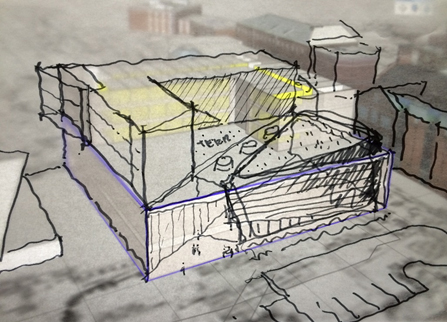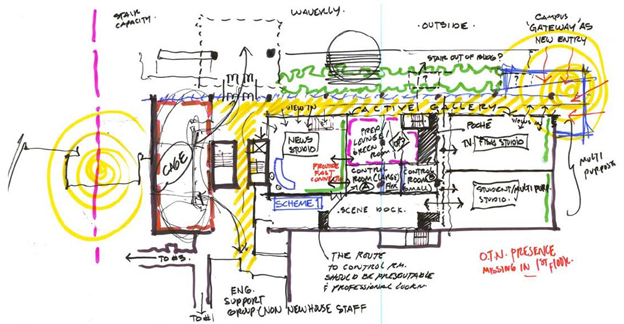Drawing. We’ve all done it. So why is it the exception not the norm in design today?
Architecture and design schools have, for the most part, stopped teaching hand drawing, so students don’t regard it as an integral part of the thinking process. Now that computers can create just about any virtual and real-looking environment, drawing is perceived as old-fashioned and slow. Contemporary culture pushes us to celebrate the newest approaches and the latest and greatest gadgets, devices and software. This is unfortunate, because while drawing currently resides on the “out” list, it should be a go-to tool for all designers. Instead it’s become the refuge of senior designers like me, who still appreciate drawing’s capacity to incite creative thinking and engender high levels of understanding.
Early stages of the design process can and should be messy. It’s important to churn through many prototypes as you see what ideas emerge. During a client visioning session, as ideas are discussed I draw them for the group. In these dynamic sessions, the real-time reaction and input moves the conversation and creative process at speeds not possible with computer drawings. Away from our offices and their sophisticated rendering software, with just a black felt-tip pen, I can demonstrate multiple design options to clients.
Hand-drawn concepts engage the group and spark discussion. When I talk about a concept using a sketch, the passion, mood and feeling communicated by the image complements the emotion of my voice. This builds a stronger connection between the design and the audience. That connection always trumps technology.
 Vignette journey for a new retail center in Al Wa’ab, Doha, Qatar.
Vignette journey for a new retail center in Al Wa’ab, Doha, Qatar.
Drawing connects with people at an emotional level. This series of sketches quickly traveled from my mind, to my hand, to the paper, and now you are seeing the journey through my eyes. The same views generated by the computer would not impart the same emotional responses or convey my particular point of view as effectively.
 Sketch over the computer screen illustrates the potential of an existing site.
Sketch over the computer screen illustrates the potential of an existing site.
Even the simple act of tracing holds tangible value. The above picture might make you want to laugh, but using trace paper over a screen lets me iterate options at lightning speed. Especially in the early design stages, time is of the essence. Only my hand can keep pace with the thought process.
 Massing Studies for an office building.
Massing Studies for an office building.
Don’t get me wrong, I am not against technology; it has its place in the creative journey. Consider these studies, which help explain the massing evolution. Rational drawings like these, with precise measurements, have a short-lived use, but complement looser drawings and studies.
 Watercolor sketch of main corner approach, Worcester Polytechnic Institute, Foisie Innovation Studio.
Watercolor sketch of main corner approach, Worcester Polytechnic Institute, Foisie Innovation Studio.
While a pen sketch effectively communicates my design solution, in some cases I turn to pencil and watercolors. The soft and appealing nature of this medium pulls the audience into the process. Its painterly style evokes emotion. By leaving certain areas unfinished, there is room for the viewer to use their mind’s eye. They can complete the picture in their own way. This harkens back to the title: seeing through the hand. This leaves certain pieces up to the imagination. And isn’t that what design is about?
 Sectional perspective, Greenfield Community College.
Sectional perspective, Greenfield Community College.
As humans we all yearn for authenticity. A design process that starts with the hand, akin to the first brush strokes on a canvas, humanizes the process and establishes a strong foundation for the later stages where computer generated precision takes precedence. So while drawing is paramount to my process, technology also plays a leading role. But starting at a computer would be like putting the cart before the horse.
About the Author: Alex Fernández is a Principal and Design Director for Gensler’s Boston office. With a relentless passion for art and design, he inspires his teams through thoughtful, well-crafted design solutions. Explore the world through Alex’s hand and eyes on his website. Contact him at alexander_fernandez@gensler.com.
More from Author
Gensler | Apr 15, 2024
3 ways the most innovative companies work differently
Gensler’s pre-pandemic workplace research reinforced that great workplace design drives creativity and innovation. Using six performance indicators, we're able to view workers’ perceptions of the quality of innovation, creativity, and leadership in an employee’s organization.
Gensler | Mar 13, 2024
Trends to watch shaping the future of ESG
Gensler’s Climate Action & Sustainability Services Leaders Anthony Brower, Juliette Morgan, and Kirsten Ritchie discuss trends shaping the future of environmental, social, and governance (ESG).
Gensler | Feb 15, 2024
5 things developers should know about mass timber
Gensler's Erik Barth, architect and regional design resilience leader, shares considerations for developers when looking at mass timber solutions.
Gensler | Jan 15, 2024
How to keep airports functional during construction
Gensler's aviation experts share new ideas about how to make the airport construction process better moving forward.
Gensler | Dec 18, 2023
The impacts of affordability, remote work, and personal safety on urban life
Data from Gensler's City Pulse Survey shows that although people are satisfied with their city's experience, it may not be enough.
Gensler | Nov 16, 2023
How inclusive design supports resilience and climate preparedness
Gail Napell, AIA, LEED AP BD+C, shares five tips and examples of inclusive design across a variety of building sectors.
Gensler | Oct 16, 2023
The impact of office-to-residential conversion on downtown areas
Gensler's Duanne Render looks at the incentives that could bring more office-to-residential conversions to life.
Gensler | Sep 13, 2023
Houston's first innovation district is established using adaptive reuse
Gensler's Vince Flickinger shares the firm's adaptive reuse of a Houston, Texas, department store-turned innovation hub.
Gensler | Aug 7, 2023
Building a better academic workplace
Gensler's David Craig and Melany Park show how agile, efficient workplaces bring university faculty and staff closer together while supporting individual needs.
Gensler | Jun 29, 2023
5 ways to rethink the future of multifamily development and design
The Gensler Research Institute’s investigation into the residential experience indicates a need for fresh perspectives on residential design and development, challenging norms, and raising the bar.
















